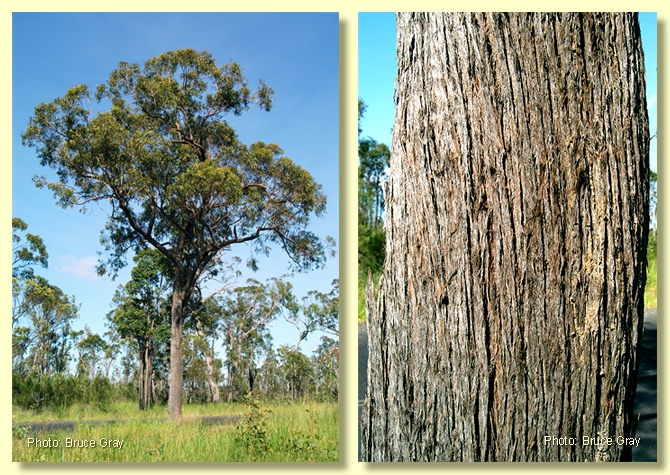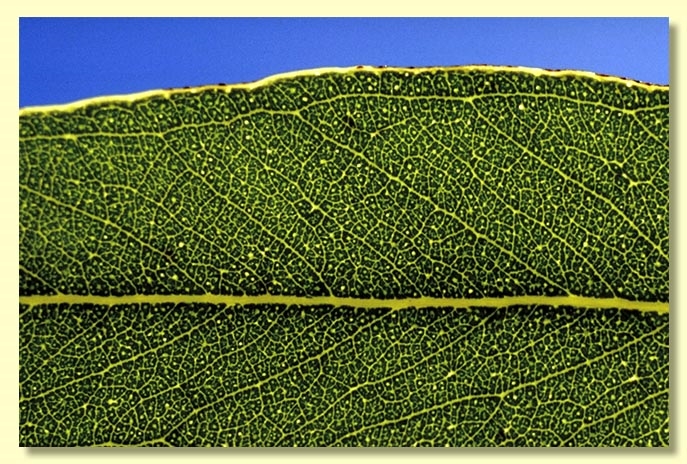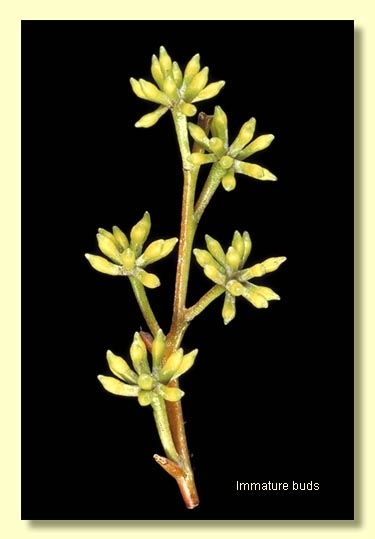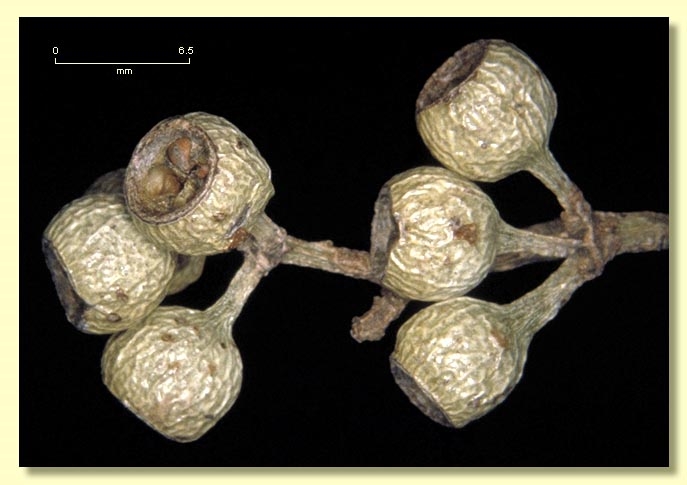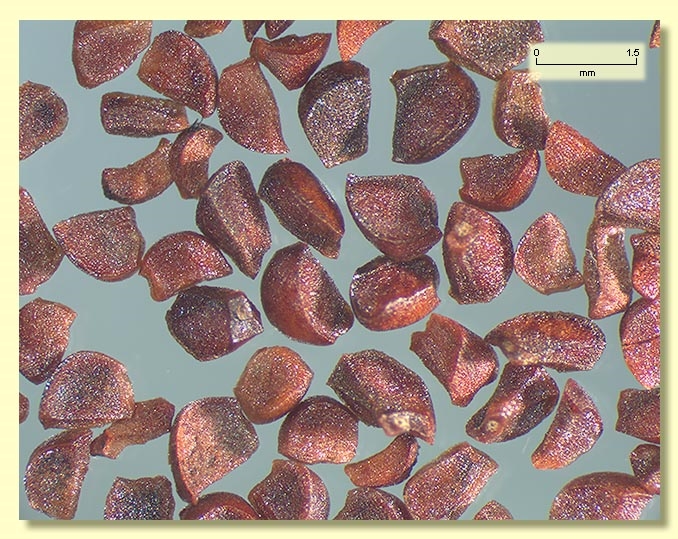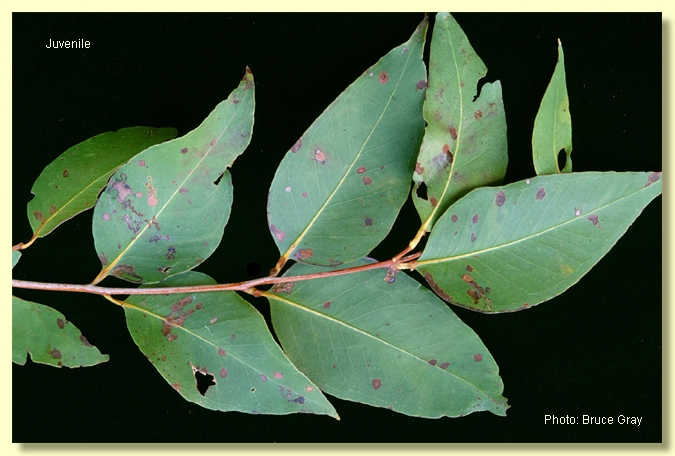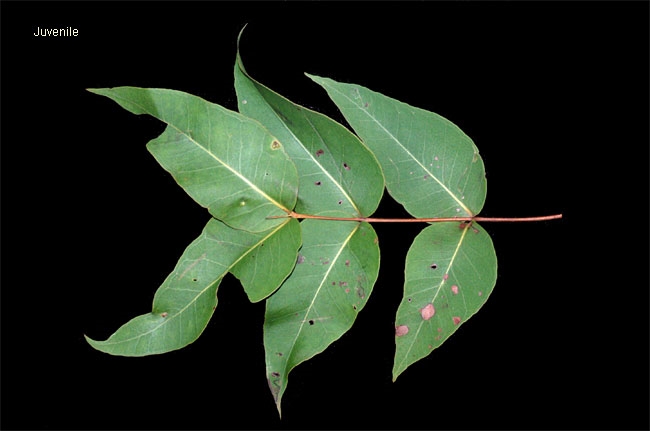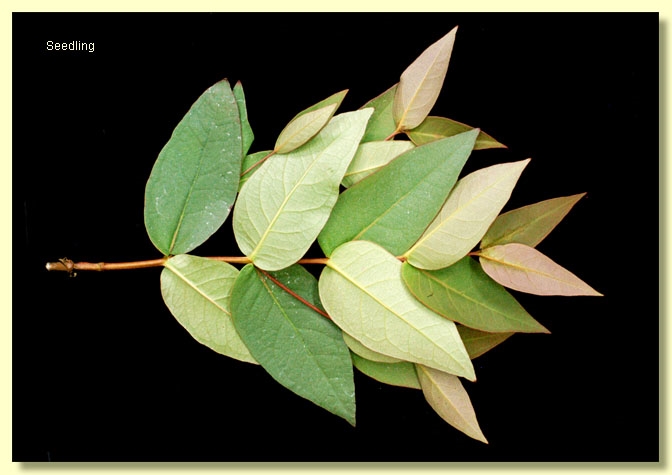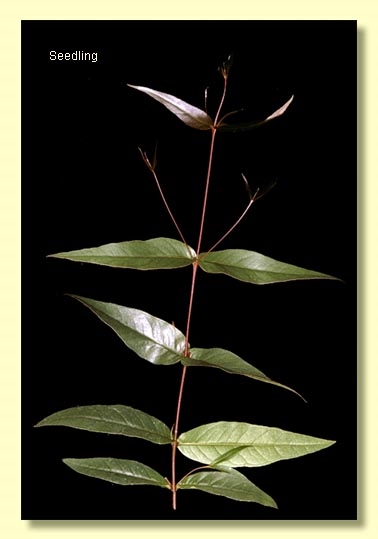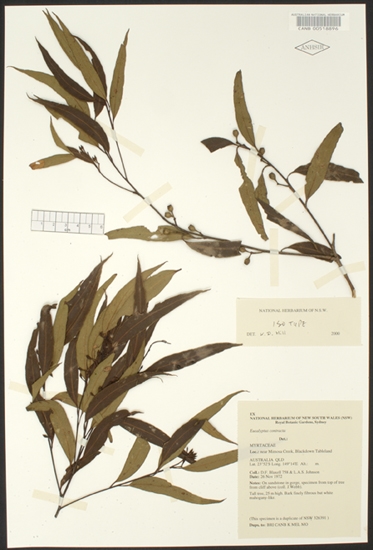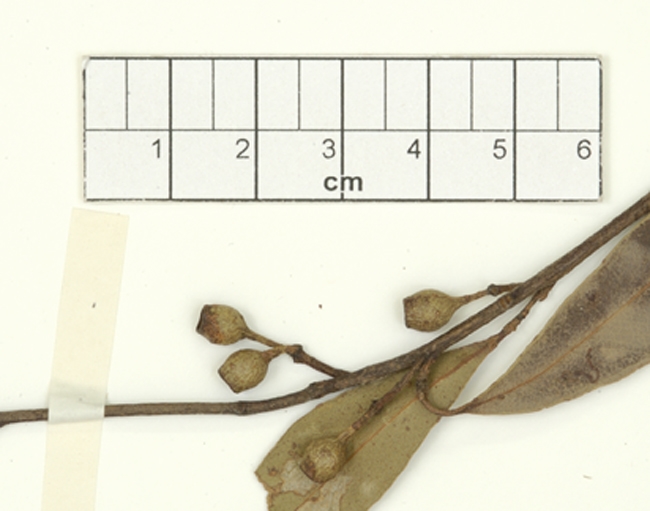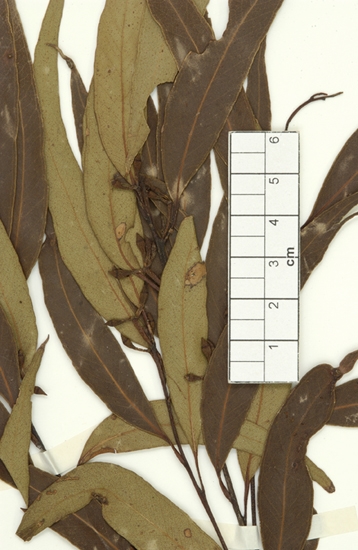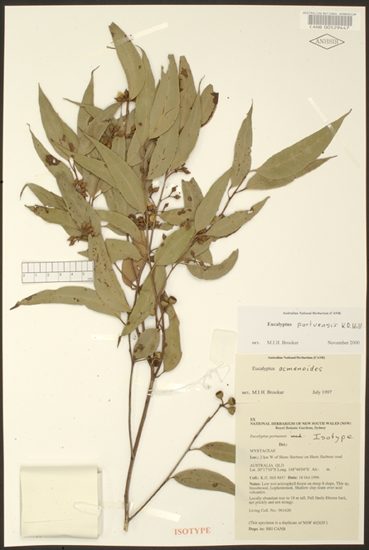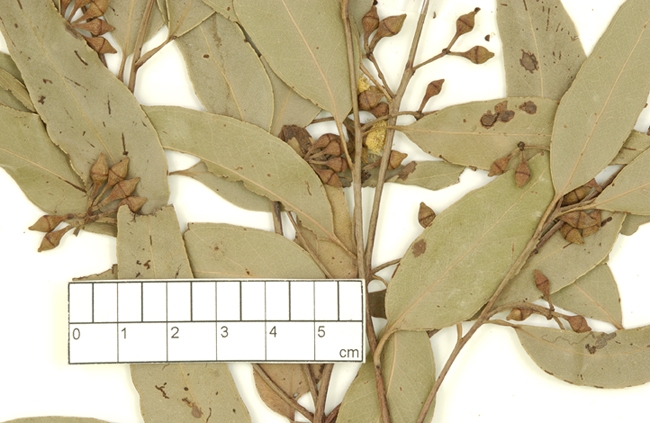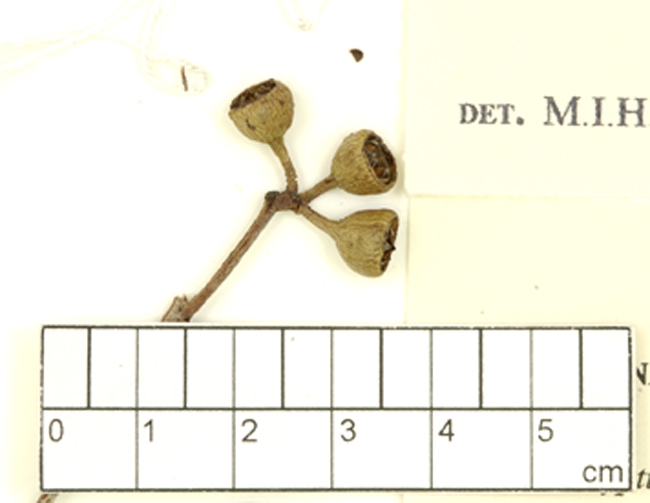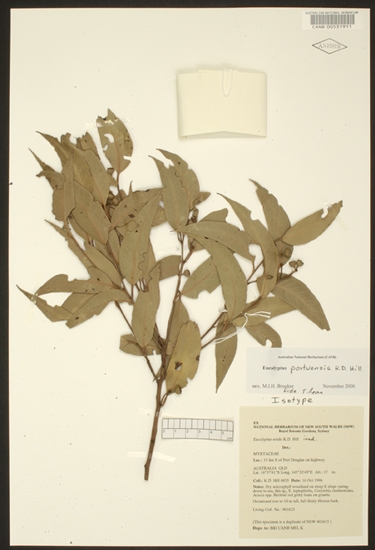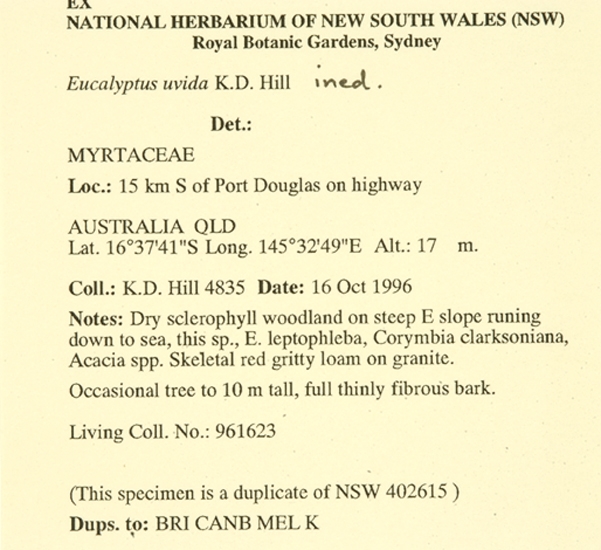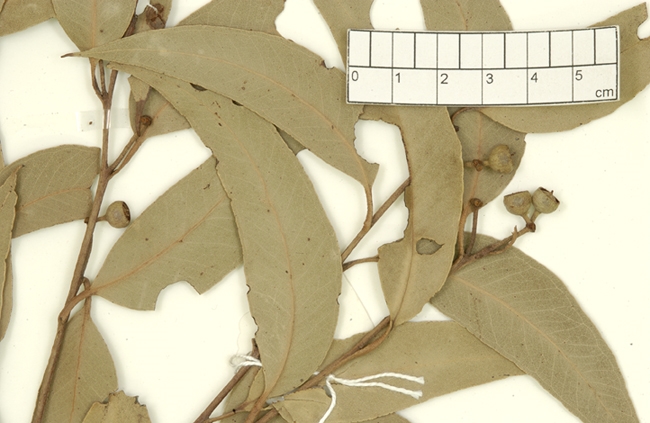Euclid - Online edition
Eucalyptus acmenoides
Eucalyptus | Eucalyptus | Amentum
Medium-sized or tall tree to 45 m. Forming a lignotuber.
Bark rough to small branches, fibrous, grey or grey-brown, held in flattish strips rather than typical stringybark.
Juvenile growth (coppice or field seedlings to 50 cm): stem rounded in cross-section, smooth; juvenile leaves opposite and sessile for many pairs before becoming alternate and shortly petiolate, usually lanceolate, rarely ovate, 5–12.5 cm long, 1.3–5.7 cm wide, base usually rounded, rarely stem-clasping, discolorous, glossy, green. Leaves become alternate at about knee-high.
Adult leaves alternate, petiole 0.7–2.1 cm long; blade lanceolate, (6.2)7–15.7 cm long, 0.9–4(5) cm wide, base oblique or tapering to petiole, margin entire, discolorous, weakly glossy to quite glossy, green, side-veins about or greater than 45° to midrib, moderately to densely reticulate, intramarginal vein parallel to and just within margin or well removed from it, oil glands island and intersectional.
Inflorescence terminal, or axillary unbranched, peduncles 0.7–1.9 cm long, buds 11 to 15 per umbel, rarely more, pedicels 0.3–0.7 cm long. Mature buds ovoid to fusiform, 0.5–0.7 cm long, 0.3–0.5 cm wide, green to yellow, scar absent, operculum conical or sometimes beaked, stamens irregularly flexed or inflexed, anthers reniform to cordate, versatile, dorsifixed, dehiscing by confluent slits, style long, locules 3–5 each with two vertical ovule rows. Flowers white.
Fruit pedicellate (pedicels 0.1–0.8 cm long), truncate-globose to hemispherical or cup-shaped or sometimes urn-shaped, 0.5–0.8 cm long, 0.4–0.9 cm wide, disc below rim level, usually descending and concealed but sometimes visible and oblique, valves 3–5, rim level or below.
Seeds brown, 1–2.5 mm long, pyramidal or obliquely pyramidal, dorsal surface smooth, hilum terminal.
Cultivated seedlings (measured at ca node 10): cotyledons reniform; stems rounded in cross-section; leaves sessile and opposite for at least 10 nodes, lanceolate, (5.5)7–12 cm long, (1.5)2–5 cm wide, base amplexicaul, margin entire, discolorous, glossy, green.
Flowering has been recorded in April, July, August, September, October, November and December.
A medium-sized to tall forest tree occurring from north of Sydney through coastal New South Wales and Queensland as far north as about Cape Tribulation. Outliers occur at Bogantungan and Isla Gorge in central Queensland and on the Blackdown Tableland. It occurs in wet sclerophyll forests on poor to moderately fertile soils. Eucalyptus acmenoides is distinguished by its short-fibred rough bark over trunk and branches, crown leaves which are weakly glossy to quite glossy green and distinctly discolorous, i.e. darker green above, obviously paler beneath (the degree of glossiness may vary within populations on slightly drier sites). Juvenile leaves are large, lanceolate and opposite until coppice is about knee-high and are conspicuous in the field because they are glossy, green and discolorous. Buds are ± ovoid and often have a conical to beaked operculum; fruit are variably truncate-globose to barrel-shaped with a thin rim and usually a concealed descending disc, but this is also variable. Fruit on trees on the Blackdown Tableland are predominantly urn-shaped, i.e. contracted slightly below the top.
Over its extensive coastal and subcoastal range E. acmenoides is likely to be confused with any completely fibrous-barked species, including all stringybark species, the ash species E. consideniana, E. piperita, E. microcorys, as well as other white mahogany species.
E. acmenoides can be distinguished from all true stringybark species by looking at the venation in the adult leaves. All white mahogany species have densely reticulate venation. The adult leaves of any stringybark species have sparsely reticulate venation, and a quick inspection of fresh adult leaves against strong sunlight will be informative. In addition stringybarks have more furrowed bark with much longer "stringy" fibres, thicker-walled fruit with prominent disc and juvenile leaves that are scabrid/hairy at the lower nodes at least. The adult leaves of stringybark species are usually concolorous, rarely some leaves only slightly discolorous, e.g. the southern E. muelleriana .
E. consideniana and E. piperita both differ from E. acmenoides in having concolorous adult leaves, and juvenile leaves that are petiolate and alternate. E. consideniana and E. piperita occur no further north than about the latitude of Buladelah in central coastal New South Wales.
E. microcorys occurs in wet sclerophyll forest from Sydney north to Gympie and thus overlaps in distribution and habitat with E. acmenoides. Both species have discolorous adult leaves with densely reticulate venation but E. microcorys differs in these features: buds are arranged in branched axillary inflorescences, the bud has a shallowly rounded operculum and, when fresh, has a visible "cross" marking reflecting its origin as 4 petals, fruit are obconical, juvenile leaves are alternate and petiolate.
E. acmenoides differs from other white mahogany species in its thin-textured and discolorous adult leaves and broadly lanceolate juvenile leaves opposite on coppice growth up to ca 1 m tall before the leaves become alternate. E. helidonica differs in the juvenile leaves being linear-lanceolate and always with stem-clasping leaf bases, persisting opposite on growth 2+ m tall. E. apothalassica differs in having predominantly concolorous leaves (never strikingly discolorous), small fruit (but overlapping in dimensions with E. acmenoides) and more inland dry sclerophyll woodland habitat. E. umbra has thicker always concolorous adult leaves, flat-topped fruit often with a broad disc easily visible, and juvenile leaves opposite at first becoming alternate while still less than 0.5 m tall. E. carnea also has thicker-textured leaves than E. acmenoides and is often concolorous or slightly discolorous, and, like E. umbra, E. carnea has juvenile leaves that become alternate early. E. psammitica differs from E. acmenoides with its has thicker-textured concolorous leaves and fruit moderately large (although overlapping in dimension with those of E. acmenoides) however has similar juvenile growth. The wide ranging E. mediocris, an inland species endemic to Queensland, also differs from E. acmenoides in having thicker concolorous or slightly discolorous adult leaves, but the two species have similar buds and juvenile growth, and fruit that overlap in shape and dimension.
Some white mahogany trees from areas such as Blackdown Tableland, the ranges immediately west of Townsville and Paluma, and the Atherton Tableland, will be difficult to assign to either E. mediocris or E. acmenoides with certainty, and indeed a population may contain individuals, some of which match one species, some of which match the other, with some individuals intermediate in character. In coastal populations of E. acmenoides north from about Proserpine, this may also be the case as the adult leaves seem to be less consistently strikingly discolorous, unlike further south. Hill (1999) created two new coastal species, E. portuensis and E. uvida, to cater for this variation and the ambiguity in disc position in the fruit . Many specimens with discolorous leaves seem to fit just as easily into E. acmenoides. Hence we have synonymised E. uvida and E. portuensis with E. acmenoides. If trees in this area have more or less concolorous leaves we would include them in E. mediocris.
Hill's Blackdown Tableland endemic species, E. contracta, is also synonymized because its stated major differences, urn-shaped fruit, slightly narrower juvenile leaves and narrower adult leaves, are within the range of variation found within E. acmenoides generally.
MORE ABOUT WHITE MAHOGANIES


